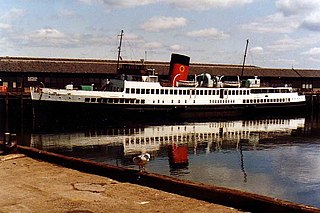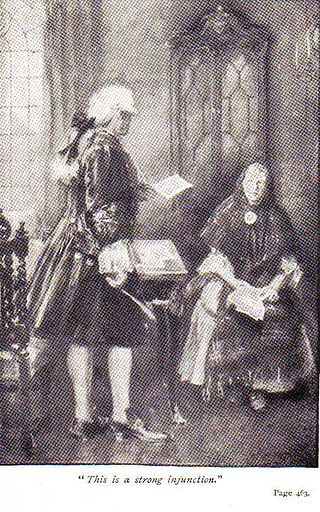
The Firth of Clyde is the mouth of the River Clyde. It is located on the west coast of Scotland and constitutes the deepest coastal waters in the British Isles. The firth is sheltered from the Atlantic Ocean by the Kintyre peninsula, which encloses the outer firth in Argyll and Ayrshire. The Kilbrannan Sound is a large arm of the Firth of Clyde, separating the Kintyre Peninsula from the Isle of Arran. Within the Firth of Clyde is another major island – the Isle of Bute. Given its strategic location at the entrance to the middle and upper Clyde, Bute played a vital naval military role during World War II.

A paddle steamer is a steamship or steamboat powered by a steam engine that drives paddle wheels to propel the craft through the water. In antiquity, paddle wheelers followed the development of poles, oars and sails, where the first uses were wheelers driven by animals or humans.

PS Waverley is the last seagoing passenger-carrying paddle steamer in the world. Built in 1946, she sailed from Craigendoran on the Firth of Clyde to Arrochar on Loch Long until 1973. Bought by the Paddle Steamer Preservation Society (PSPS), she has been restored to her 1947 appearance and now operates passenger excursions around the British coast.

The Clyde steamer is the collective term for several passenger services that existed on the River Clyde in Scotland, running from Glasgow downstream to Rothesay and other towns, a journey known as going doon the watter.

MV The Second Snark is a small passenger ferry, built in 1938 by William Denny of Dumbarton, later operated by Clyde Marine Services on the Firth of Clyde, Scotland.

The Caledonian Steam Packet Company provided a scheduled shipping service, carrying freight and passengers, on the west coast of Scotland. Formed in 1889 to complement the services of the Caledonian Railway, the company expanded by taking over rival ferry companies. In 1973, they were merged with MacBraynes as Caledonian MacBrayne.

PS Duchess of Montrose was a paddle steamer launched in 1902 and operated by the Caledonian Steam Packet Company as a River Clyde excursion steamer. She saw active service during the First World War after being requisitioned by the Admiralty and converted into a minesweeper. She was lost near Dunkirk on 18 March 1917 after striking a mine.
Duchess of Norfolk was a 381 GRT paddle steamer built in 1911 for the London, Brighton and South Coast Railway and London and South Western Railway, who operated a joint service to the Isle of Wight. She was requisitioned by the Royal Navy for use as minesweeper HMS Duchess of Norfolk during the First World War, returning to her owners after the war ended. She passed to the Southern Railway on 1 January 1923.

MV Keppel is a passenger-only ferry built in 1961 for the Tilbury to Gravesend crossing. She had twenty years of service on the Largs to Millport route. Since 1993, she has operated in Malta.

PS Caledonia was a paddle steamer built in 1934. She principally provided an Upper Clyde ferry service, later moving to Ayr and then Craigendoran.

DEPV Talisman was the world's first diesel-electric paddle vessel. Built in 1935, she was a passenger ferry on the Clyde, seeing wartime service as HMS Aristocrat. From 1953, she served for 14 years on the Millport station.

PS Iona was a MacBrayne paddle steamer, which operated on the Clyde for 72 years, the longest-serving Clyde steamer.

Jeanie Deans is a fictional character in Sir Walter Scott's novel The Heart of Midlothian first published in 1818. She was one of Scott's most celebrated characters during the 19th century; she was renowned as an example of an honest, upright, sincere, highly religious person. The name "Jeanie Deans" was given to several pubs, ships, railway locomotives, an opera, a play, a poem, a song, a hybrid rose, an antipodean potato, and a geriatric unit in a hospital. They all take their name from Scott's heroine. There was also a so-called Jeanie Deans' Cottage in Edinburgh. It was demolished in 1965.
PS Minerva was a 306 GRT passenger paddle steamer that J&G Thomson launched in 1893 for the Glasgow and South Western Railway (G&SWR). She served with the Royal Navy from 1916 and was sold into civilian service in Turkey in 1924. She was scrapped by 1928.
PS Glen Rosa was a 306 GRT passenger paddle steamer that J&G Thomson launched in 1893 for the Glasgow and South Western Railway (G&SWR). She served with the Royal Navy in the First World War as HMS Glencross. She was absorbed into the London, Midland and Scottish Railway fleet in 1923, transferred to the Caledonian Steam Packet Company in 1938 and scrapped in 1939.
PS Waverley was a Clyde-built paddle steamer that carried passengers on the Clyde between 1899 and 1939. She was requisitioned by the Admiralty to serve as a minesweeper during World War I and again in World War II, and was sunk while participating in the Dunkirk evacuation in 1940. The current PS Waverley, launched in 1946, was built as a replacement for this vessel.

PS Eagle III was a passenger-carrying paddle steamer that was built and sailed on the Clyde, and was twice requisitioned by the Admiralty to serve as a minesweeper during the world wars.

PS Duchess of Fife was a paddle steamer built in 1903 for the Caledonian Steam Packet Company. She spent most of her career serving passenger routes in the Firth of Clyde and was requisitioned for use as a minesweeper during both World Wars. In 1940 she took part in the Dunkirk evacuation, rescuing a total of 1,633 allied troops.
PS Waverley was a Clyde-built paddle steamer that carried passengers on the Clyde between 1885 and 1887, then on the Bristol Channel from 1887 until 1916, when she was requisitioned by the Admiralty to serve as a minesweeper during World War I.

PS Lucy Ashton was a Clyde-built paddle steamer that carried passengers on the Clyde between 1888 and 1949. She was one of the longest serving Clyde steamers.















